Posted in category "Saints"
Former communist and socialist countries are now turning to religious tourism to bring in believers and their money.
Bulgarian archaeologists and clerics say they have unearthed bones belonging to St. John the Baptist. The remains – small fragments of a skull, bones from a jaw and an arm, and a tooth – were discovered embedded in an altar in the ruins of the ancient monastery.
The remains were discovered in July 2010 during the excavation of a fourth-century monastery on St. Ivan Island off Bulgaria’s Black Sea coast. They were in a sealed reliquary buried next to a tiny urn. A Greek inscription on the stone casque contains a reference to June 24 – the date on which John the Baptist is believed to have been born. 
“We found the relics of St John the Baptist – exactly what the archaeologists had expected,” said Bozhidar Dimitrov, Bulgaria’s minister without portfolio and a former director of the country’s National History Museum, who was present when the stone urn was opened.
Officials of this recession-torn country think the proported relics will give a big boost to tourism, drawing believers from neighboring Orthodox Christian countries to this nearby resort town.
“I’m not religious but these relics are in the premier league,” said Simeon Djankov, Bulgaria’s finance minister and an avowed atheist. “The revenue potential for Bulgaria is clear.”
News of the find, meanwhile, is already drawing visitors. At the local church of St. George in Sozopol, where the presumed relics are now on temporary display in a silver chest donated by Bulgaria’s prime minister, hundreds of faithful line up for a chance to view the bones, saying prayers and making the sign of the cross.
The church attendance at daily Mass has rocketed from about 100 to more than 3,000. Church officials say they are now selling more votive candles in a day than they used to sell in a year, and have ordered another two tons of them to meet projected demand.
The bones now make Bulgaria a member of the club of nations that say they are home to pieces of John the Baptist, who was beheaded on the orders of King Herod. Ancient tradition has held that his severed head was entombed in Herod’s palace.
Over time, body parts believed to be his have spread across Europe, the Middle East and Southeast Asia. A church in Calcutta, India, claims to house part of a hand.
The cathedral in Aachen, Germany, says it has the cloth used to wrap John the Baptist’s head after his decapitation. The Topkapi Palace in Istanbul, Turkey, the former seat of the Ottoman emperors, also claims to hold parts of one of his arms and his head.
The presence of the relics of St. John the Baptist hasn’t translated into a tourist bonanza in any of these other resting places. Still, people in Bulgaria remain hopeful.
There are some encouraging signs. Milenna Dimitrova, who has been selling fresh berries, figs and jams for 20 years from a stall near the church, says business has been so brisk that she doesn’t have time to go hereself. “The season was awful before–this is clearly a gift from God,” she said.
On March 16, 2010 the Holy See announced that Pope Benedict XVI will preside over the beatification of the Venerable John Henry Newman on September 19, 2010. The location for the Mass hasn’t been decided yet, but the site of the former MG Rover factory is now the “preferred venue†for Benedict XVI’s beatification of Cardinal Newman. It is easier for security, and is closer to the place where Cardinal Newman will be venerated: Birmingham Oratory. One of the concelebrants of the Mass is sure to be the Most Rev. Vincent Nichols, Archbishop of Westminister and head of the Roman Catholic Church in England and Wales.
In preparation for his beatification, in October 2008 authorities opened Cardinal Newman’s grave to exhume and rebury his body. Gay rights activists protested the separation of Newman from his longtime companion with whom he shared his burial place. The idea of Catholic pilgrims going to the gravesite of two men to venerate one of them as a “Blessed” was too uncomfortable for church authorities to tolerate.
In a queer coincidence on the eve of Newman’s beatification, Birmingham Oratory experienced an upheaval over a relationship between the provost of the Oratory and a young man. Their relationship appeared to echo Cardinal Newman’s relationship with a priest, Fr. Ambrose St John a century before.
At the heart of the conflict are the allegations surrounding a close but chaste friendship between the former Provost of Birmingham Oratory, Fr. Paul Chavasse, and a young man. Fr. Chavasse had also served as Actor for the Cause of Newman’s canonization. He has been replaced in both positions by the Very Rev. Richard Duffield. 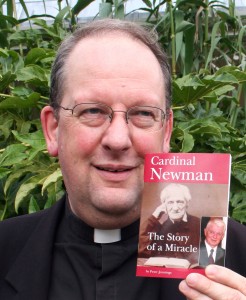
“Around 2 1/2 years ago, in the autumn of 2007, Fr. Chavasse began to form an intense but physically chaste friendship with a young man, then aged 20, which the Fathers of Birmingham Oratory regarded as imprudent,” an Oratory spokesman said. The young man had been rejected as a candidate for the priesthood, and Fr. Chavasse had complained on his behalf. Fr. Chavasse assured skeptical members of the community that he was not sexually involved with anyone, but these men continued to confront Fr. Chavasse and informed Rome of their concerns and suspicions.
Fr. Felix Seldon was appointed to conduct an “apostolic visitation” of the Birmingham Oratory. Here is the upshot:
– Fr. Paul Chavasse “willingly” resigned as Provost of the Oratory and also as Actor for the Cause of Newman’s canonization in December 2010 – less than a year before Newman’s beatification. He was directed to leave for a long retreat, or a fund raising trip to America–depending on which news story you read. Anyway, he’s vanished.
– The three members of the Birmingham Oratory that complained the loudest about Fr. Chavasse–Fr. Philip Cleevely, Fr. Dermont Fenlon and Br. Lewis Berry have been ordered “to spend time in prayer for an indefinite period” in religious houses hundreds of miles apart. No date was given for their return to the Birmingham Oratory.
An Oratory spokesman downplayed the homosexual allegations of the conflict. He explained there had been disagreements in the community how best to approach the beautification of their founder, Cardinal Newman. Fr. Fenlon, Fr. Cleevely and Br. Lewis were described on one blog as “known upholders of tradition and conservative Catholic values.” They have publicly opposed an interpretation of Cardinal Newman as a patron of conscientious dissent. As a theologian, Cardinal Newman played an important role in developing the modern formulation of the primacy of conscience, which is of fundamental importantance to gay and lesbian Catholics who reject in good conscience the standard teaching on sexuality.
The three men have also publicly protested the Catholic Bishops’ Conference of England and Wales lack of vigorous opposition to sex education and relationships policy in schools put in place by the British government. Archbishop Vincent Nichols is president of the Catholic Bishops’ Conference. He previously served as Archbishop of Birmingham from 2000 to 2009.
Bishops of any stripe don’t appreciate publicity-seeking troublemakers. With the halogen glare that will accompany the pope’s visit in September, I’m not surprised all four men were sent packing to distant monasteries.
Questions about Cardinal Newman’s sexuality revived when he was exhumed in 2008.
Newman, a founder and member of the Birmingham Oratory, was buried in the small cemetery at Rednal near the Oratory County house. At his request, he was buried with Fr. Ambrose St John.
At the request of the Vatican, the British government gave permission for the cardinal’s remains to be transferred from Rednal into a sarcophagus that will stand between the marble columns opposite the Holy Souls’ Altar in Birmingham Oratory Church. The Vatican is understood to have made the request so that Roman Catholic pilgrims could come and pray at Newman’s tomb. It is not traditional for veneration to occur at shared tombs.
Responding to recent insinuations in the British press that Cardinal John Henry Newman was gay and was an intellectual forefather of today’s dissenters from Catholic teaching, Fr. Ian Ker, the author of the “definitive” biography of Newman, called the claims that the cardinal was gay are “absolute rubbish.” He says there is “irrefutable evidence of Newman’s heterosexuality.”
This evidence rests in the “sacrifice” to a life of celibacy to which Newman felt he had been called at age 15. “A modern reader should not need to be reminded that in 19th century England homosexuality was illegal and generally considered to be immoral,” wrote Fr. Ker. “The only ‘sacrifice’ that Newman could possibly been referring to was that of marriage,” he said.
In a article entitled “John Henry Newman and the sacrifice of celibacy,” published in L’Osservatore Romano on September 3, 2009, Fr. Ker comments that “the decision to exhume the body of Venerable John Henry Newman has provoked reactions, in particular on the part of the homosexual lobby.” According to Ker, this “protest” carries the idea that “Newman wanted to be buried with his friend because he had some kind of bond with him or something more than just a simple friendship.”
When Fr. Ambrose St John, who was 14 years his junior, died in 1875, Newman compared his own grief to that of a husband’s for a wife. “I have ever thought no bereavement was equal to that of a husband’s or wife’s, but I feel it is difficult to believe that any can be greater, or anyone’s sorrow greater, than mine.”
Newman wrote in his diary about Fr. St John’s love for him: “From the first he loved me with an intensity of love, which was unaccountable.” He later added: “As far as this world was concerned, I was his first and last…he was my earthly light.”
The cardinal repeated on three occasions his desire to be buried with his friend, including shortly before his death in 1890. “I wish, with all my heart, to be buried in Fr Ambrose St John’s grave – and I give this as my last, my imperative will,” he wrote, later adding: “This I confirm and insist on.”
The two men had a joint memorial stone that is inscribed with the words he had chosen: Ex umbris et imaginibus in veritatem (Out of shadows and phantasms into the truth.”)
British gay rights activist Mr. Peter Tatchell observed: “It is impossible to know whether or not the relationship between Newman and St John involved sexual relations. Equally, it is impossible to know that it did not.”
“To be fair and to err on the side of caution, given both men’s rather orthodox religious beliefs,they probably did not have a sexual relationship. It is likely that they had a gay orientation but chose to abstain from sex. Sexual abstinence does not, however, alter a person’s orientation. A person can be gay and sublimate hteir gayness into spiritual and artistic pursuits, and into strong, intense platonic same-sex relationships, which is probably what Newman and St John did.”
“But many of these platonic relationships were, in fact, expressions of latent homosexuality which never fund physical expression because the men concerned lived in a homophobic culture where they either had no conception of the possiblity of same-sex love or, for religious reasons, dared ot express this love sexually.” 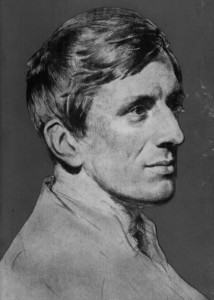
“Ker’s article is full of bald assertions that Newman was heterosexual, but it offers no proof or evidence. It dismisses the possibility that the Cardinal could have had a relationship with St John and even condemns the plausible suggestion that he might have been gay and celibate.”
The history of the Catholic Church is littered with popes, cardinals, bishops and priests who were secretly gay. Down the ages, lots of clergy have had gay relationships. Indeed, about one-quarter of the current Catholic priesthood is estimated to be gay. Why should anyone be surprised by the suggestion Cardinal Newman might have had a same-sex relationship?”
The sexuality of Newman has long been a subject for conjucture. Charles Kingsley’s famous attack on Newman for his dishonesty, insincerity and sexual ambiguity. Kingsley compared Rome’s Catholic descendants as treacherous and effeminate and the pagan Germanic people or their English Protestant descendants as honest, trustworthy, and physically strong defenders of truth. When in 1864 Kingsley asserted that “truth, for its own sake had never been a virtue with the Roman clergy . . . [and] Father Newman informs us that it need not, and on the whole ought not to be; that cunning is the weapon which Heaven has given to the saints wherewith to withstand the brute male force of the wicked world which marries and is given in marriage,” Newman roared back with his seminal work Apologia Pro Vita Sua.
John Henry Newman’s first steps toward Roman Catholicism came from his participation, study and writings as part of the Oxford Movement. This religious movement began 1833 by Anglican clergymen at Oxford University to renew the Church of England by reviving certain Roman Catholic doctrines and rituals. This attempt to stir the Established Church into new life arose among a group of spiritual leaders in Oriel College, Oxford. Prominent among them were John Henry Newman Richard Hurrell Froude. Froude died in 1836 at the age of 33. Newman, 35 years old at the time, was profoundly moved by his death. 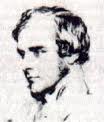
The idea that the Oxford Movement contained a significant stream of homoeroticism was popularized by Sir Geoffrey Faber in the book Oxford Apostles – A Character Study of the Oxford Movement, published in 1933. One commentator declared, “Of the mutually feminine attachment which bound Newman and Froude together, there is no need to say more.”
In his journal of the late 1820s Froude records his struggle against “vile affections” and, referring to an unnamed undergraduate private pupil, cautions himself “above all (to) watch and pray against being led out of the way by the fascination of his society.”
Newman’s poems of the 1830s echo similar themes (“A Blight”), but also use well-known Biblical male pairs to make suggestive homosexual statements (“David and Jonathan” and especially “James and John,” with its reference to a state where “man may one with man remain.”
To his elegiac poem, “Separation of Friends,” Newman added these final lines after the death of Froude in February 1836:
“Ah! dearest, with a word he could dispel
All questioning, and raise
Our hearts to rapture, whispering all was well,
And turning prayer to praise.
And other secrets too he could declare,
By patterns all divine,
His earthly creed retouching here and there,
And deepening every line.
Dearest! he longs to speak as I to know,
And yet we both refrain:
It were not good; a little doubt below,
And all will soon be plain.”
“But isn’t it about time,” said one commenter on a British news site, “that the Church stopped all this hypocritical nonsense and admit that the man they are about to beatify was gay, and that he was in loved with Fr Ambrose St John to the extent where they even wanted to get buried together. They may well have lived chaste lives and suppressed their sexuality successfully, but you cannot get around the content of the letters passing between the two of them.”
“And instead of branding Newman as ‘intrinsically disordered’, and effectively saying that he should never have been a priest, let alone a Cardinal, as the current regime would have to say, they should celebrate the life of a wonderful thinker, a truly gifted writer, and a man who was not ashamed to express his love for another man while at the same time observing a celibate life.”
“I can’t believe the irrational and inhuman knots this hierarchy ties itself up in.”
These two books provide interesting reading on Cardinal Newman’s sexuality and careful expression: in The Friend (2003) the late historian Alan Bray presented major research on the relationship between Newman and St John, sifting thorugh the Cardinal’s diary, letters and notes. Secret Selves: Confession and Same-Sex Desire in Victorian Autobiography (2009) by Oliver Buckton argues that literary “secrecy”–the very act of holding back information in a novel or memoir–was a primary and provocative indicator of Victorian homosexuality. One of the works he examines in his book is Cardinal Newman’s Apologia Pro Vita Sua.
A great deal more can be said by quite consciously saying much less.
My first Nihil Obstat post about Cardinal Newman – “Keep it Secret” – can be found here.
The January edition of the Magnificat included the story of St. Reinold, religious and marytr (980 c.) He died at the hands of stone masons and later came to be venerated as their patron saint. 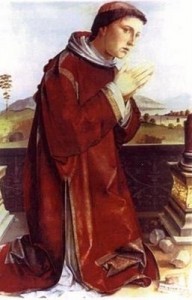
There are various versions of his life and martyrdom. St. Reinhold may have been a monk, a knight, a pilgrim–or all three. He may be a fabrication of several different people, stories and legends. Even his murder may have several explanations.
Version I: Reinold was a Benedictine monk of the monastery of Saint Pantaleon in Cologne, Germany. He was entrusted with the duty of overseeing the construction work to complete the abbey.
Reinold was murdered by the stone masons working on the building. They beat him to death with their hammers and threw his body into a pool of water near the Rhine river.
In one telling, Reinold is killed due to his “over-strenuous diligence,” which incurred the hostility and bitter resentment of the stone masons. In a second account, he was murdered by stone masons who were annoyed that Reinold worked harder and with more skill then they did.
Reinold’s fellow monks were unable to find his body until its whereabouts were made known in a private revelation to an infirm poor woman. His body was taken to the abbey and buried with honor.
Version II: St. Reinold was drawn from the story of Renaud, the youngest son of Duke Aymon of France. He was supposedly a descendant of the sister of Charlemagne, and the 4th son mentioned in William Caxton’s romantic poem, Romance of the Foure Sonnes of Aymon.
The four sons of Duke Aymon are Renaud, Richard, Alard and Guiscard, and their cousin is the sorcerer, Maugis. Maugis was raised by the enchantress Oriande la Fee. He won the magical horse Bayard–who could understand human speech–and the sword Froberge which he later gave to Renaud.
The oldest extant version of the story of Renaud de Montauban and his cousin, Magris, was the anonymous Old French chanson de geste Quatre Fils Aymon which dates from the late 12th c.
In the tale, Renaud and his three brothers were sons of Aymon of Dordone. They flee from the court of Charlemagne after Renaud kills another of Charlemagne’s nephews in a brawl over a chess game. Renaud kills the man by battering him with a chess board. A long war follows, during which Renaud and his brothers remain faithful to the Christian chivalric code.
The four brothers are pardoned on the condition Renaud go to the Holy Land on crusade (or on a pilgrimage), and their magical horse Bayard, who could expand his size to carry all four brothers, be surrendered to Charlemagne. 
Charlemagne orders Bayard to be drowned by chaining it to a stone and throwing it in the river Meuse, but the horse escapes and lives forever more in the Ardennes forests.
After further adventures soldiering in the Holy Land, Renaud returns home. On his return he abandons his home and gives himself up to religion. He eventually makes his way to Cologne and enters the monastery of St. Pantaleon, where be works as a mason on the Church of St. Peter. He is murdered by jealous fellow masons. His body is miraculously saved from the river and magically makes its way home to his brothers in a cart.
In art, St. Reinold is depicted with armor, reflecting the tradition that he had been a soldier before entering monastic life. He is also shown as a Benedictine monk with a stone mason’s hammer; as a monk being killed by stone masons, and as a dead monk being thrown in water.
Besides his identity, I have three other mysteries to solve: 1) why was he murdered; 2) why was he named a saint; and strangest of all, 3) Why he was named a patron saint of the group of people who killed him?
Here are my two versions:
Story 1: Brother Reinold is two people: pious in prayer and a mean, overbearing, and cruel overseer. Hatred and resentment build up among the stone masons he supervises. He oversteps his bounds one day, striking, kicking or punishing someone he bullies to push them to work harder. The man or his friend strikes back in self defense or in a fury. The others finish the job and try to get rid of the body. A local poor woman knows where the body was disposed, and tells the monks the place came to her in a dream from God. The monks find the body and attribute it to divine revelation. They don’t pursue the killers because they know Reinold was a creep and they need their abbey completed. Over the years, long after all the murderers and monks are dead, Brother Reinhold becomes a patron saint of stone masons because he was associated with them, and his *martyrdom* came at their hands.
Story 2: A former warrior named Renaud shows up at the Monastery of St. Pantaleon in Cologne after soldiering in the Holy Land. They can’t pronounce his French name and it comes out sounding like “Reinold.” He comes from an aristocratic family, a descendant of the legendary Charlemagne, and cousin to a famous sorcerer. He makes sure everybody knows it, and the fact he has given it all up to follow a monastic life. He is tough, skilled and hard, and drives himself and everyone around him with a religious zeal. Newly devout, Renaud hectors the other half-pagan stone masons about their lives and picks fights with them. One day, they turn on him in a group and kill him. The body is never found, although local legend has it returning to France in a magical cart–derived, no doubt, from his stories about his horse, Bayard.
Could there have been a darker meaning behind his death? Some historical evidence points to a Christian-Pagan clash or ritual: according to the book, The Ciphers of the Monks by David A. King, German stone mason’s marks (Steinmetzzeichen) were often based on the runes. They chiseled these marks into the stones, especially the foundation stone, as their signature. I can see how that would fill a zealous Christian with horror and anger–an affront to the consecration of the building.
Two hundred years earlier another Benedictine, St. Boniface, was bludgeoned and hacked to death for insulting the gods. 
Medieval people also used “foundation sacrifices” or burials to ensure the stability of a building–castle, bridge and sometimes, churches. They also had a tradition of sacrificing people to placate the spirits of a place. The sacrificed person, in turn, became its protector. Often these were children, sometimes adults, who were entombed alive within the structure. In other sacrifices a dead person was thrown into a pool of water as a votive offering. Could this been what happened to Reinold?
If a monk-mason named Reinold ever existed, and whatever the reasons were behind his death, ultimately the church profited by his romantic and legendary associations. Over time he became “St. Reinold,” martyred for the faith by fellow stone masons jealous of his example.
In one of those delicious ironies the Catholic Church is so famous for, he becomes their patron saint and protector.
I did notice that mason’s hammers bear a strong resemblance to Mjollnir, the hammer of Thor. Just a coincidence, or a subtle clue to his killers? 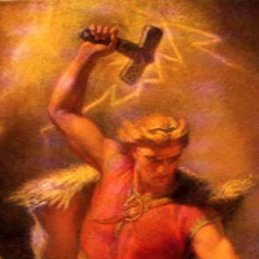
Thumbing through my copy of Magnificat in church last week, I came upon the story of Saint Ethelfleda. Her tale breathes a warm, oddball humanity–in contrast to the usual Magnificat fare of sanctity, torture and grim death for aspiring saints.
Saint Ethelfleda is someone I can relate to: swims naked, prays outdoors, entertains generously, and inspires young people.
Here are her miracles of renown, and those of her teenage admirer – who went on to surpass her in weird tales.
Saint Ethelfleda (c.930 – Feast Day – October 23) was a member of the Anglo-Saxon nobility. Following the death of her husband, she spent the rest of her life as abbess of Romsey. Her devotional acts included chanting psalms while standing naked in the cold water of the River Test.
One day, as Ethelfleda was preparing for a visit from her kinsman, King Athelstan, the royal chamberlain arrived in advance to see if she had the provisions necessary to host the king and his large retinue. Upon being informed by the chamberlain that she lacked an adequate supply of ale, Ethefleda answered, “My patroness, the Virgin Mother, will send me an abundance of ale.” She thereupon withdrew to an oratory of the Blessed Virgin, where she ardently prayed for heavenly intervention.
When on the next day the king and his men arrived after attending Mass, Ethelfleda’s modest barrel of ale supplied all they wanted without running dry.
Her legend also tells that she spent time with the king and queen at court, where Ethelfleda’s habit–for “ascetic reasons” –of bathing in the nude at night was the occasion of the queen’s nervous illness, brought on by the queen’s “indiscreet curiosity” when she followed her to see where she went. The queen was afterward cured by the abbess’ intercession.
The Magnificat story ended by saying the elderly Ethelfleda was frequently visited by a teenage boy who drew inspiration from her example. The youth was the future abbot of Glastonbury and archbishop of Canterbury – Saint Dunstan.
Saint Dunstan (909?-May 19, 988, Feast Day – May 19) was born near Glastonbury and lived for a time in the household of Saint Ethelfleda’s kinsman, King Athelstan. The dreamy young man became a great favorite of the king, his relatives and other members of the court became jealous and envious. They accused Dunstan of studying heathen literature and black magic, and prevailed upon the king to order him to leave the court. 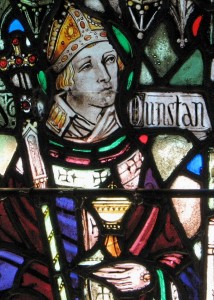
As he was departing Dunstan was attacked. According to various accounts, he was beaten and thrown in a duck pond or cesspool, where his enemies pushed him face down in the muck.
He fled to Winchester and entered the service of Bishop Aelfheah the Bald, who endeavored to persuade him to become a monk. Dunstan was doubtful about whether or not he had the vocation to celibate life, but an outbreak of tumors all over his body–probably from blood-poisoning caused by the treatment to which he had been subjected, changed his mind. 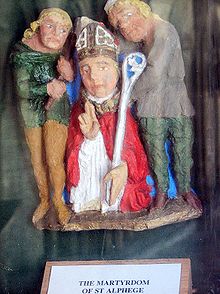
He made his profession at the hands of St. Aelfheah (“Elf-high”) and returned to live the life of a hermit at Glastonbury, working on his forge and playing his harp. Here the Devil is supposed to have appeared to tempt him, and Dunstan seized him with his blacksmith tongs and made him promise never to enter a house with a horseshoe over the doorway.
Dunstan also worked as a silversmith and in the scriptorium while he was living at Glastonbury. Dunstan drew his own self-portrait in the small, kneeling monk beside Christ in the Glastonbury Classbook. The inscription reads: “I ask you, merciful Christ, to watch over me, Dunstan. May you not permit the Taenarian storms to swallow me.” 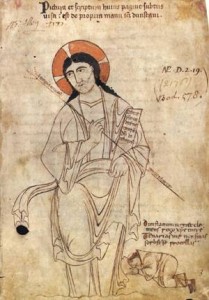
Did Saint Dunstan delve into occult practices in his youth? Perhaps. It has been speculated that his famous fight with the Devil was in fact a battle with his own desire to fully resume his former practices and studies.
The sketch in his own hand showing Dunstan holding the hem of Christ’s garment; and his petition for Christ’s aid to save him from the underworld–or Hell–may be more illuminating than we realize about his inner and outer life.
The “heathen literature” Saint Dunstan studied when he was younger may have been some Irish manuscripts describing druid practices and beliefs that survived Saint Patrick’s efforts at destroying all of them. His early education was received from Irish monks at Glastonbury. Dunstan obviously had access to manuscripts by Ovid or other ancient Greeks with his reference to “Taenarian storms” – Taenarius or Taenarus is the path or gateway to the underworld or Hades.
At least one person thought St. Dunstan might have practiced or dabbled in magic: William Godwin (1756-1836) , who included him in his book, Lives Of The Necromancers: Or An Account Of The Most Eminent Persons In Successive Ages, Who Have Claimed For Themselves, Or To Whom Has Been Imputed By Others, The Exercise Of Magical Power. The book was published in 1834. The other necromancer of ancient Britain Godwin cited was Merlin.
Goodwin asserted that at least one of Saint Dunstan’s “miracles” was really magic. As the story goes Eadmund, a young king of 18, sought the advice of Dunstan, but the jealousy of the courtiers was aroused and he was driven from court.
“For, a few days later, the king rode out to hunt the stag in Mendip Forest. He became separated from his attendants and followed a stag at great speed in the direction of the Cheddar cliffs. The stag rushed blindly over the precipice and was followed by the hounds. Eadmund endeavoured vainly to stop his horse; then, seeing death to be imminent, he remembered his harsh treatment of St. Dunstan and promised to make amends if his life was spared. At that moment his horse was stopped on the very edge of the cliff. Giving thanks to God, he returned forthwith to his palace, called for St. Dunstan and bade him follow, then rode straight to Glastonbury. Entering the church, the king first knelt in prayer before the altar, then, taking St. Dunstan by the hand, he gave him the kiss of peace, led him to the abbot’s throne and, seating him thereon, promised him all assistance in restoring Divine worship and regular observance.” (Catholic Encyclopedia)
At that time Dunstan was 19 or 20 years old. He became the Keeper of the Treasure and the chief adviser to the king. When his royal friend was stabbed in May 946 by the outlaw Leof, the abbot buried him in the abbey.
It sounds like a spell Merlin would have concocted to change the king’s heart.
A counselor to successive kings, Dunstan continued to have potentially fatal run-ins with them. On the day of his coronation in 956, newly crowned King Eadwig left his banquet to join two women in bed–the king’s foster-mother, and her daughter, Aelfgifu. Dunstan followed in a fury and dragged the startled king back to the hall and his knights. The episode, no surprise, led to Dunstan’s exile and flight for his life.
Besides the number of times he was thrown out of court and then restored, Dunstan’s life was notable for the number of visions of angels and demons, including a warning by angels that he would die within three days. He did.
“..for all his life this unique and marvellous man had revelation of things distant in space and in time, and his happy spirit, full of the artist, metal-worker, lover of tunes and gay, lived on the edge of this world; the good and the evil of the unseen supported and attracted him as they do such few as are placed on the outposts of humanity.” (Hilaire Belloc, History of England)
Lesbian and gay saints have contributed in their individual ways to the life of the Church. Two examples are Saint Alcuin, who openly professed his emotional and sexual passion for several brother monks; and Saint Bridget of Ireland, who deeply loved the young nun, Darlughdach, who slept with her and sometimes functioned as her ambassador.
There are also gay icons–the handsome youth, Saint Sebastian, and Saint Joan, a woman who dressed herself in men’s clothing, became a warrior, and defied the gender role and expectations of her time.
Of course, there is also Saint Peter Damien with his fixation on gay male sex. He is the epitome of a self-hating homosexual who persecutes others of his kind in order to avoid detection, and punish the objects of his own desire.
Here are two clues to help identify gay and lesbian saints: 1) did they enter religious life partially to avoid marriage; and 2) does part of their story involve a special “friend” they had in religious life?
Today’s lesson: Saint Galla of Rome. 
In his Dialogues, Pope Saint Gregory the Great speaks of a holy woman of Rome named Galla, who had been married for less than a year when her husband died. Refusing to remarry, the young widow resolved to devote the rest of her life to God. To protect her beauty againt men’s attention, it is said she disguised herself as a man and God gave her a beard.(!)
Joining with a community of women living near St. Peter’s Basilica, caring for the poor and sick, this wealthy and pious woman founded a convent and a hospital. She is reputed to have once healed a young deaf and mute girl by blessing some water, and having the girl drink from it.
As she lay stricken with breast cancer, Galla kept two candles burning each night at the foot of her bed, for Gregory explains, “She hated darkness, being a friend of light, physical as well as spiritual light.”
It was between these two candles that one night the Apostle Saint Peter appeared in a vision to Galla. The dying woman asked him: “Have my sins been forgiven?” Smiling, Peter nodded yes and answered, “They are forgiven. Come.”
But Saint Galla now requested, “I beg you to let Sister Benedicta come with me.” Peter told her, “Sister Benedicta will follow you in thirty days.” Three days later, Galla died, and a month later, Benedicta.
Rest together in peace.
Death: c. 550 A.D.
Feast Day: October 5












